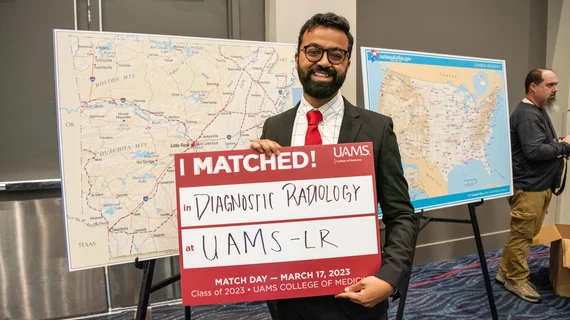Diagnostic radiology applicants significantly less likely to ‘match’ than peers in other specialties
Diagnostic radiology applicants were likely to “match” into a training program than their peers in other specialties in 2018 and 2022, according to new research published Tuesday.
Changes to the application process have made it more difficult to predict which individuals will be successful in finding a program. Researchers with the University of Massachusetts also analyzed the “magic number” of ranks required for an applicant to have a 90% chance of matching into diagnostic radiology. The figure has nearly tripled since 2014 for U.S. MD seniors, up to 14 in 2022, researchers detailed in Current Problems in Diagnostic Radiology [1].
“This number has been increasing over the past 10 application cycles reflecting increasing competitiveness in the field for a variety of reasons,” Trenton Taros, MD, a resident physician who studied at the UMass Chan Medical School in Worchester, and colleagues wrote July 9.
For the study, the authors analyzed data from the National Resident Matching Program, logged between 2014 and 2022. They pinpointed all matched and unmatched diagnostic radiology applicants and quantified factors such as number of ranks and publications. Compared to the average U.S. MD senior applicant for each match cycle, students applying in diagnostic radiology were much more likely to match in 2014, 2016 and 2020. However, they were significantly less likely to match in 2018 and 2022.
The magic number of ranks required for an applicant to have a 90% chance of matching into DR trended upward, rising from 5 in 2014 to to 14 in 2022. Number of publications also increased during the same period, Taros and colleagues noted.
“For applicants in 2022, this meant that they needed to rank 6 more programs than their peers applying in 2019 and 2020 to have the same chance of matching,” the authors wrote. “A prospective rank list that an applicant could have been relatively comfortable with in years prior now might necessitate additional consideration and assistance from mentors. This has incentivized applicants to apply to as many programs as possible. This trend not only adds to the difficulty of pursuing their desired career, but also the logistics and expense associated with the interview season.”
Taros et al. see “clear implications” for radiology program directors. Increased competitiveness likely will lead to more qualified candidates. But programs are likely to face “formidable” administrative burden in reviewing thousands of applications in two months or less. The authors also speculated reasons why DR is becoming more competitive. An increased emphasis on remote work since the pandemic likely played a part, as did the growing desire for work-life balance among medical trainees.
“While the driving forces behind these trends are less clear, changes from the COVID-19 pandemic and increased medical student exposure to DR are possible factors,” the study concluded. “More research is needed to determine how changes in the application process will affect programs and applicants, which factors are driving the increased competitiveness in DR, and what equitable solutions can help match eager students and programs.”

